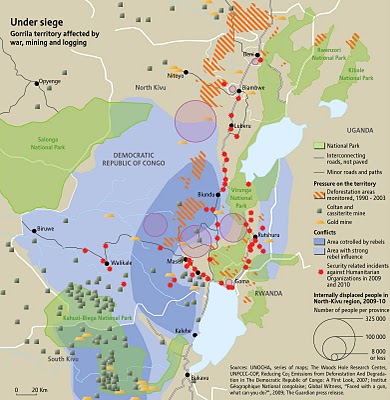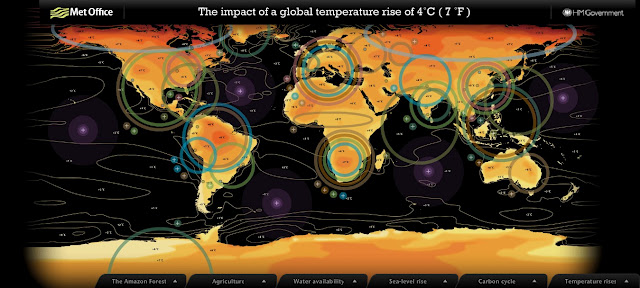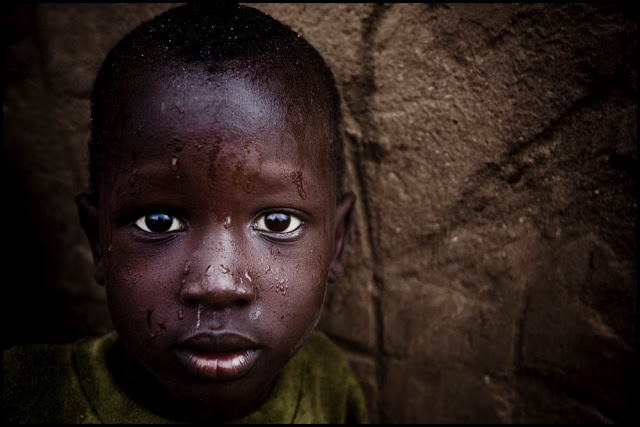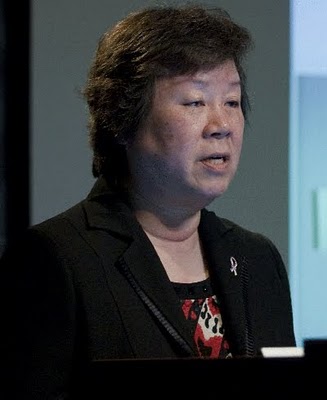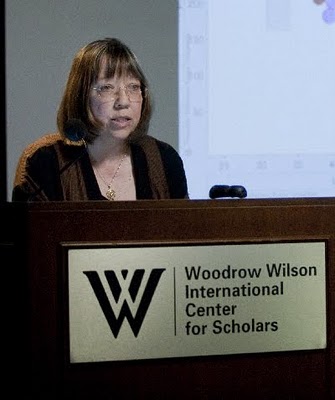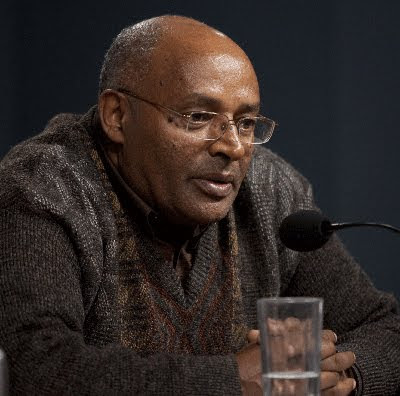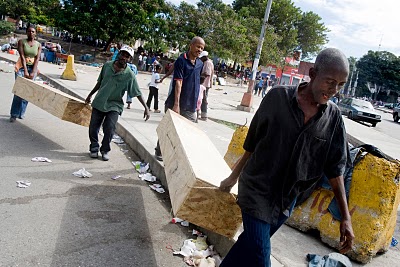-
Guerrillas vs. Gorillas in the Congo Basin
›Gorillas could disappear from the Congo basin in the next 10-15 years, according to a new report issued by the United Nations and Interpol. The Last Stand of the Gorilla – Environmental Crime and Conflict in the Congo Basin places responsibility for the decline of gorilla populations in the Democratic Republic of the Congo and its surrounding region squarely on the shoulders of resource-hungry militants, who poach gorilla bushmeat to feed hungry soldiers and mine workers and sell in local markets. Militants extract timber, charcoal, diamonds, and other resources to raise funds for arms, reducing gorilla territory.
Yet another rationale is retaliation against park rangers who attempt to limit their illegal activities within national parks. In the process, park rangers have found themselves, their parks, and their endangered charges targets of militant groups seeking to plunder and traffic goods through protected areas. “In Virunga Park alone, 190 park rangers have been killed in the last 15 years,” notes the report, which is also available in an interactive e-book edition.
Conflict with local communities also frequently leads to the slaughter of the gorillas and loss of their habitats. Displaced people and refugees also compete with gorillas for land. In several cases, gorillas facing shrinking natural domains have satisfied their appetites in banana plantations, and local farmers have struck back.
Strengthening Law Enforcement
Not all, however, is dire. The report finds several success stories stemming out of transboundary law enforcement collaboration and recommends increased training and support for local and international law enforcement groups. “The gorillas are yet another victim of the contempt shown by organized criminal gangs for national and international laws aimed at defending wildlife,” said David Higgins, Interpol’s Environmental Crime Programme Manager. “The law enforcement response must be internationally coordinated, strong, and united, and Interpol is uniquely placed to facilitate this.”
Law enforcement in the Congo Basin faces an uphill battle, in part due to conditions present in peace agreements between guerillas and the Congolese government. Removing vehicle checkpoints from important border crossings was key to the insurgents agreeing to peace. While these agreements reduced violence, they have created a highway for illegal exports. This trade props up the militant groups and undercuts the chances for peace on a regional scale. It is an example of how large remaining quantities of automatic weapons and turns to poaching by ex-militants can render post-conflict environments even more damaging to local wildlife than war itself.
Toward Coexistence
In some locations, conflicts between gorillas and local farmers are disappearing with the construction of natural barriers and as local populations realize the potential of ecotourism to generate greater revenue from thriving gorilla populations than collapsing ones. Greater international coordination and local commitment, however, are necessary. Turning threatening competition into beneficial cooperation is possible.
Tara Innes is a PhD student at the University of Maryland, studying conflict-environment linkages.
Photos: Gorilla, courtesy Flickr user mrflip; Gorilla Territory Affected by War, Mining, and Logging courtesy UNEP/GRID-Arendal. -
The Plight of Urban Refugees in Nairobi
›“The Traditional image of life in tented sprawling camps no longer tells the full refugee story.”– Hidden and Exposed: Urban Refugees in Nairobi, Kenya
Coinciding with the end of UN-HABITAT’s 5th World Urban Forum, a new report and associated video, Hidden and Exposed: Urban Refugees in Nairobi, Kenya, have been released by the Humanitarian Policy Group (HPG) at the Overseas Development Institute (ODI) and the International Rescue Committee (IRC).
Hidden and Exposed removes the cloak of migration stereotypes and provides an unfiltered look at urban migrants’ struggle for daily survival. Focusing on seven neighborhoods with high refugee concentrations in Nairobi, the authors — through qualitative interviews and secondary data — found a unique, challenging urban environment for thousands of refugees. Aid and development groups often overlook these urban refugees, instead favoring work with traditional established camps on the urban periphery.
The HPG found that Nairobi’s 46,000 registered refugees represent a diverse mix of ethnic groups and nationalities, all trying to secure economic independence and security. While much research has been devoted to the traditional concept of displaced migrants in centralized ex-urban camps, such as Dadaab in Eastern Kenya, urban dwellers are just as vulnerable to insecurity, poverty, and harassment. With nebulous legal rights, facing discrimination and protected by only fragile support systems, the refugee community in Nairobi finds itself in a precarious situation.
In light of the challenges, the research team at HPG offered three basic recommendations as initial steps:
1. Protection:
2. Livelihoods:- Address confusion over legal rights to prevent issues of police harassment and community violence.
- Target a subset of donor funds for training local police forces and government agencies.
- Establish partnerships between the UNHCR and the Kenyan government to improve the latter’s Refugee Status Determination System.
- Funnel humanitarian and development aid toward legal aid services while also using innovative strategies to increase dialogue between urban refugees and the surrounding Kenyan communities.
3. Service Delivery:- Carry out surveys to better understand the Nairobi urban economy, including the informal sector.
- Support the government of Kenya in their efforts to help urban refugees to become self-reliant.
- Recognize the transition of refugees from sequestered camps to urban areas and develop an effective response.
- Secure Kenyan government permission for the issuance of work permits for refugees.
Fleeing conflict and attracted by the possibility of better jobs, services, or security, thousands of refugees have sought new lives in Nairobi. Yet the reality for many urban migrants is an existence burdened with inadequate assistance, a precarious legal status, and economic and physical insecurity. Through the implementation of these recommendations, HPG hopes to draw attention to these hidden refugees, and offer them the hope of improved livelihoods and effective security.- Design aid models to address the unique challenges faced by urban refugees in Nairobi.
- Ensure coordinated and comprehensive services, in conjunction with the Kenyan government and international organizations, to address the needs of the urban refugees and the surrounding communities, with particular attention granted to refugee women and girls.
-
Climate Change and Energy in Defense Doctrine: The QDR and UK Defence Green Paper
›March 30, 2010 // By Dan Asin
“The Department of Defense is not the U.S. government lead for climate change, but we certainly can show leadership in this area,” Deputy Assistant Secretary of Defense for Strategy Amanda Dory recently told an audience at the Woodrow Wilson Center. “That’s true of energy as well.”
-
Megatrends: Embracing Complexity in Today’s Population and Migration Challenges
›March 29, 2010 // By Geoffrey D. DabelkoForeign Policy’s Elizabeth Dickinson recently sat down with UN High Commissioner for Refugees António Guterres for a wide-ranging interview on the global refugee crisis. Yet a strong theme emerges across the continents: The complexity of today’s conflicts belies either easy or quick solutions.
-
Maintaining the Momentum: Highlights From the Uganda International Conference on Family Planning
›“Family planning is to maternal survival what a vaccination is to child survival,” said Johns Hopkins professor Amy Tsui, quoting Khama Rogo of the World Bank, at the Woodrow Wilson Center event Maintaining the Momentum: Highlights From the Uganda International Conference on Family Planning on March 16. Rogo made the strong statement during the landmark November 2009 conference in Kampala, which has renewed interest in family planning and reproductive health among African leaders and development partners. Rhonda Smith of the Population Reference Bureau and Sahlu Haile of the David and Lucile Packard Foundation joined Tsui, the director of The Bill & Melinda Gates Institute of Population & Reproductive Health, to discuss their impressions of the Kampala conference and what it means for the future of family planning in Africa.
“An event that happened at the right time”
“Kampala was the work of a community,” said Tsui. More than 50 organizations—the U.S. Agency for International Development, the UN Population Fund, the World Bank, the World Health Organization, and the Gates and Packard Foundations—convened in Uganda, which was chosen not only for its central location, but also to highlight the country’s soaring unmet need for contraception—41 per cent—and rapid 3.1 percent population growth rate.
Panels focused on key issues in family planning, including:- Integrating family planning into HIV/AIDS care
- Integrating family planning in post-abortion, postpartum, child, and other primary health care
- Expanding contraception delivery services by community health workers
- Increasing outreach to youth and men
- Capitalizing on private and public innovations in service delivery and financing
- The United States announced its foreign assistance budget will increase support for family planning from $450 million to $715 million for the next fiscal year.
- The Global Health Initiative identified maternal/child health and family planning as one of its main priority themes.
- Secretary of State Clinton positively discussed girls’ education, family planning, and reproductive health at the ICPD + 15 anniversary.
- The Women Deliver 2010 Conference, to be held in June, has identified family planning as a third pillar of maternal health.
Uganda on the Move Rhonda Smith’s presentation “Uganda on the Move”—which she also presented in Uganda—is a prototype of the Population Reference Bureau’s new ENGAGE (Eliminating National Gaps—Advancing Global Equity) project, which is designed to “engage policy audiences and promote policy dialogue around issues of high fertility and high unmet need for family planning and their costs, consequences, and solutions,” she said. By using stunning, innovative graphics and avoiding confounding technical terms, ENGAGE’s products are designed to reach non-technical policy audiences and influential decision-makers.
Rhonda Smith’s presentation “Uganda on the Move”—which she also presented in Uganda—is a prototype of the Population Reference Bureau’s new ENGAGE (Eliminating National Gaps—Advancing Global Equity) project, which is designed to “engage policy audiences and promote policy dialogue around issues of high fertility and high unmet need for family planning and their costs, consequences, and solutions,” she said. By using stunning, innovative graphics and avoiding confounding technical terms, ENGAGE’s products are designed to reach non-technical policy audiences and influential decision-makers.
As one of the Uganda conference’s most talked about presentations, “Uganda on the Move” wows audiences with visuals created using Hans Rosling’s Trendalyzer software. The presentation shows that although Ugandans are increasingly healthier, have a higher life expectancy, and are more educated, maternal health remains in jeopardy. Tellingly, 46 percent of pregnancies in the country are unplanned, 6,000 women die each year from complications related to pregnancy, and 1,200 women die each year from undergoing unsafe abortions.
Maternal deaths, however, do not tell the whole story: For every one woman dying, Smith said, 20-30 women suffer from short-term disability, which places a major strain on economic growth. From 2004 to 2013, maternal death will cost Uganda US$350 million in lost productivity; and disability will cost and additional US$750 million.
What Next? The African Perspective “After 10 years of virtual clandestine work, [family planning] is just coming out of the closet,” said Sahlu Haile. Over the last few decades, family planning advocates have been struggling to: 1) keep family planning alive—without it being affected by political considerations 2) make family planning a health priority, without any associations with rights violations; and 3) be in solidarity with pioneering organizations of the family planning movement, like the International Planned Parenthood Federation, that were victims of discriminatory funding decisions.
“After 10 years of virtual clandestine work, [family planning] is just coming out of the closet,” said Sahlu Haile. Over the last few decades, family planning advocates have been struggling to: 1) keep family planning alive—without it being affected by political considerations 2) make family planning a health priority, without any associations with rights violations; and 3) be in solidarity with pioneering organizations of the family planning movement, like the International Planned Parenthood Federation, that were victims of discriminatory funding decisions.
The Uganda conference changed all that, said Haile. In Uganda, conference attendees were “talking about family planning…not reproductive health, not maternal/child health.” This, he said, was “probably the single most important lesson…that I took from the Kampala conference.”
Following the conference, Haile said that African government officials stressed family planning as a priority at meetings in Ethiopia and Nigeria—the first time he had witnessed such high-level attention to family planning from those countries in his 30-year career.
In Ethiopia, African leaders pledged to:- Prioritize family planning, since family planning is one of the most cost-effective development investments;
- Ensure access to contraception, as 40 percent of maternal deaths are associated with unwanted pregnancies; and
- Integrate MDG 5b, universal access to reproductive health, into their international development plans and budgets.
Haile credited the Kampala conference for spurring these efforts. In December, he joined a task force of 14 Ethiopian organizations to plan the next steps. They will jointly develop research capacities, generate evidence, and strengthen monitoring and evaluation practices, especially with regard to integrating population, health, and environment efforts. In addition, they will engage with wider audiences via new tools such as the blog RH RealityCheck and Gapminder Foundation’s Trendalyzer program.
Haile believes we need to “work together to encourage national-level efforts…to make sure family planning stays where it is now and make sure it is not abandoned.”
To be a part of the new online family planning community, join the Kampala Conversation.
Photo 1: A women and her children in Jinja, Uganda. Courtesy Flickr user cyclopsr. Photos of Amy Tsui, Rhonda Smith, and Sahlu Haile courtesy of Dave Hawxhurst, Woodrow Wilson Center. -
Demographic Trends
›Worldfocus recently featured two pieces on the Arab world’s burgeoning population. “Demographics of the Arab World,” a radio broadcast, brings together Magda Abu-Fadil of the American University in Beirut and Bernard Haykel of Princeton University for a look at the region’s demographic trends. Despite possessing different political systems and being at different levels of economic development, demographic challenges of youth bulges, emigration, and gender gaps are common to countries across the Arab world. “Arab World Experiences Rapid Population Explosion,” a written interview with demographer Patrick Gerland of the United Nations Population Division, tackles similar issues. Topics of discussion include demographic variations between Middle Eastern nations, fertility rates, the consequences of the region’s youth bulge, and best- and worst-case scenarios for the Arab world’s future.
State of the World’s Cities 2010/2011: Bridging the Urban Divide is the most recent edition of UN-HABITAT’s biennial outlook into global population centers. Analyzing the “the complex social, political, economic, and cultural dynamics of urban environments,” the report explores the “ways in which many urban dwellers are excluded from the advantages of city life.” UN Secretary General Ban Ki-Moon draws a connection between cities and climate change in the report’s preface, writing, “With over half the world’s population now living in cities, and cities making a disproportionate contribution to climate change, urbanization is one of the ‘crucial agendas’ of our time.” -
‘Wilson Center on the Hill:’ Haiti’s Long Road Ahead
›March 25, 2010 // By Wilson Center StaffNearly two months after the devastating 7.0 magnitude earthquake in Port-au Prince, Haiti, the country still needs assistance to provide basic healthcare and shelter, in addition to rebuilding Haiti’s economy, government, and institutions. As the international community and NGOs make the transition from emergency disaster relief to long-term reconstruction and capacity-building efforts, donor coordination and long-term commitment are crucial. Recently, on Capitol Hill, a panel of experts organized by Wilson Center on the Hill and the Wilson Center’s Latin American Program discussed Haiti’s continuing problems and challenges.
Patience Necessary
Johanna Mendelson Forman, a senior associate for the Americas Program at the Center for Strategic and International Studies, stressed that progress in Haiti will take time—perhaps five years to rebuild and 10 years to see positive economic growth. This timeline is often frustrating for donors—including Congress and U.S. citizens—who want to see immediate results, she noted. Nevertheless, Mendelson Forman discounted the myth that “because Haiti is a weak state it is not a sovereign state,” and emphasized that developing and strengthening the Haitian government remains necessary.
She observed that the post-earthquake efforts in Haiti have been different from previous United Nations interventions, particularly in terms of the Latin American community’s involvement. Brazil, for example, is leading relief operations. Other Latin American countries—including Haiti’s neighbor, the Dominican Republic—have committed to promoting a stable and secure Haiti. Here Mendelson Forman noted a new partnership initiated by the Dominican and Haitian governments. “[Dominican officials] understand that they are doomed if Haiti is doomed,” she said. “As members of the international community, it is our job to foster that reconciliation.”
Costs Are Rising
Andrew Philip Powell, a regional economic advisor in the Caribbean Country Department at the Inter-American Development Bank (IDB), said that while the IDB initially estimated damage from the earthquake at about $8 billion, the complete destruction of the government and commerce centered in Port-au-Prince could push that number much higher. The IDB and partner organizations are currently conducting a Post-Disaster Needs Assessment that will ultimately identify the official damages and ballpark the cost of reconstruction.
Powell stated that Haiti is “not starting from a blank slate,” citing a development strategy agreed upon in April 2009 by the Haitian government and international donors. In keeping with the strategy, he emphasized the need for effective coordination between donors and the Haitian government. At the same time, he said it is vital to encourage population dispersion by shifting government agencies and private-sector jobs to other parts of the country. Haiti needs roads and communication networks outside of the capital area, as well as export processing zones in outlying regions, to increase the economic opportunities outside of Port-au-Prince, he said.
However, with the large amounts of aid flowing into the country, Powell warned donors and Haitian officials to remain on the lookout for “Dutch disease”—a decline in the manufacturing sector following a sharp increase in natural resource prices, foreign assistance, or foreign direct investment. Its occurrence could increase Haiti’s dependency on aid in the future.
Challenges for Healthcare
Sheri Fink, a public policy scholar at the Woodrow Wilson Center and senior fellow at the Harvard Humanitarian Initiative, offered her perspective on Haiti’s continuing health crisis based on two trips to the country in the earthquake’s aftermath. There are signs of hope, including some normalcy and commerce returning to the camps, she noted, but problems in the health sector as a whole are increasing. As field hospitals put in place after the earthquake close, “there is a fear among Haitians that attention is starting to turn elsewhere,” she said.
According to Fink, “the work is far from done” in Haiti, a sentiment she said is shared by many departing health workers. The hospitals left standing are not prepared to deal with the influx of patients arriving at their doors following the closure of field hospitals, and government health workers are currently working without pay.
Fink also pointed out the risk of long-term earthquake-related health problems, including injuries suffered during aftershocks or from falling debris, inflamed chronic diseases, horrible conditions and lack of basic health services in camps, and the “looming nightmare” of infectious disease epidemics.
Fink called for more international involvement to avert a widening of the health crisis. “We’ve made a big commitment and to follow-up on the investment, to make it mean something; let’s not be satisfied with just bringing things back to where they were,” she said.
By Sarah Huston and David Klaus of Wilson Center on the Hill at the Woodrow Wilson International Center for Scholars.
Photo: Courtesy Flickr user United Nations Development Programme -
The Feed for Fresh News on Population
›March 25, 2010 // By Wilson Center StaffUSAID’s Gloria Steele offers written testimony on the FY2011 Global Health and Child Survival (GH CS) budget request before the House Appropriations Subcommittee on State, Foreign Operations
Andrew Revkin gives a shout-out to family planning and notes the lack of population discussion at Copenhagen in his blog post, “From Wishful Thinking to Real-World Action on Climate“
Video of Secretary of State Hilary Clinton addressing the Commission on the Status of Women in which she discusses the Global Health Initiative, maternal mortality, family planning, and “gendercide“
Family planning-environmental connections headline PATH‘s March edition of Outlook
Youth bulges and social conflict are noted in Nicholas Kristoff’s recent article on child marriages in Yemen
Follow Geoff Dabelko on Twitter for more population, health, environment, and security updates
 A Publication of the Stimson Center.
A Publication of the Stimson Center.


